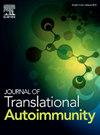Matrix remodeling-associated protein 5 as a novel biomarker for predicting disease activity and endoscopic response to infliximab in Crohn's disease
IF 3.6
Q2 IMMUNOLOGY
引用次数: 0
Abstract
The primary objective of treating Crohn's disease (CD) is to achieve and sustain endoscopic remission. However, repeated endoscopic examination leads to decreased patient compliance and procedural risks. Non-invasive biomarkers for endoscopic activity of CD are thus promising in clinical use. This study compared proteomic profiles between inflammatory and non-inflammatory intestinal tissues on 10 active CD patients through liquid chromatography–tandem mass spectrometry, and identified 384 differentially expressed proteins. Four candidate secretory proteins (MXRA5, AZU/HBP, CRYAB, DEFA3) were validated via ELISA in serum from 74 CD patients (43 active CD and 31 in remission). Serum MXRA5 levels were notably increased in CD patients in remission compared to active cases (P < 0.001) and showed an inverse correlation with SES-CD scores (r = −0.33, P < 0.05). ROC analysis demonstrated MXRA5's utility in distinguishing endoscopic activity of patients with CD (AUC = 0.80), which was improved when combined with CRP (AUC = 0.89). Besides, higher baseline serum MXRA5 levels predicted better endoscopic response to infliximab (IFX). In conclusion, our study indicates that MXRA5 might serve as a new potential serum biomarker for CD activity and IFX response prediction. Further prospective and muli-center studies are needed to validate its predictive performance.
基质重塑相关蛋白5作为预测克罗恩病疾病活动性和内镜下对英夫利昔单抗反应的新生物标志物
治疗克罗恩病(CD)的主要目的是实现和维持内窥镜缓解。然而,反复的内镜检查导致患者依从性降低和手术风险。因此,内窥镜下CD活性的非侵入性生物标志物在临床应用中很有前景。本研究通过液相色谱-串联质谱法比较了10例活动性CD患者炎症性和非炎症性肠道组织的蛋白质组学特征,鉴定出384种差异表达蛋白。通过ELISA对74例CD患者(43例活动性CD, 31例缓解期CD)血清中的4种候选分泌蛋白(MXRA5、AZU/HBP、CRYAB、DEFA3)进行了验证。与活动期患者相比,缓解期患者血清MXRA5水平显著升高(P <;0.001),并与SES-CD评分呈负相关(r = - 0.33, P <;0.05)。ROC分析显示,MXRA5在鉴别CD患者的内镜活动方面具有实用价值(AUC = 0.80),与CRP联合使用(AUC = 0.89)可提高该功能。此外,较高的基线血清MXRA5水平预示着对英夫利昔单抗(IFX)的内镜反应更好。总之,我们的研究表明MXRA5可能作为一种新的潜在的血清生物标志物,用于CD活性和IFX反应预测。需要进一步的前瞻性和多中心研究来验证其预测性能。
本文章由计算机程序翻译,如有差异,请以英文原文为准。
求助全文
约1分钟内获得全文
求助全文
来源期刊

Journal of Translational Autoimmunity
Medicine-Immunology and Allergy
CiteScore
7.80
自引率
2.60%
发文量
33
审稿时长
55 days
 求助内容:
求助内容: 应助结果提醒方式:
应助结果提醒方式:


